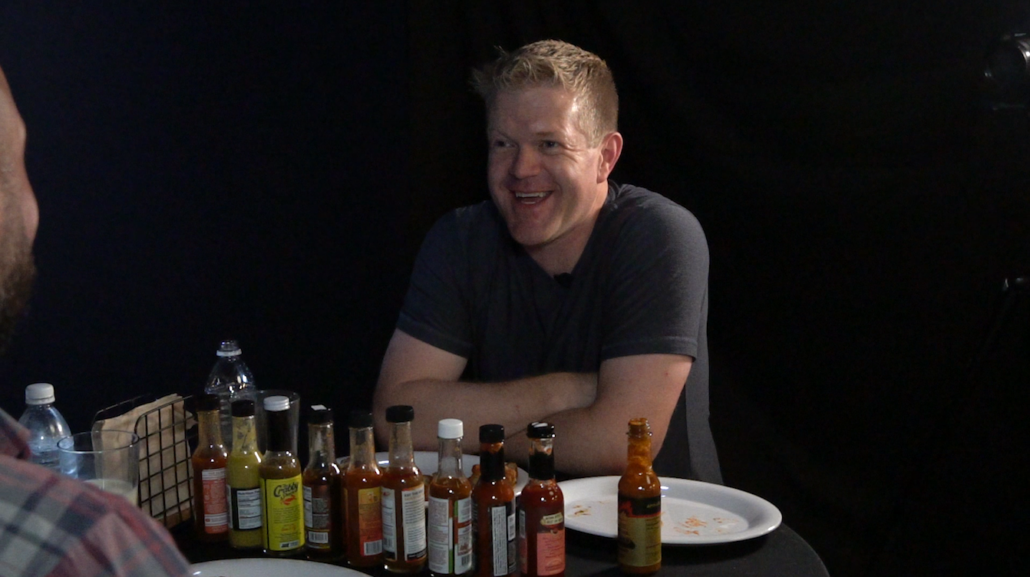Twenty chicken wings. Ten hot sauces. A dark backdrop carefully illuminated with a healthy dose of stage lighting. Nerves. Guts. Water. A tall glass of cold milk. It’s a familiar scene for fans of the hit YouTube show Hot Ones–where host Sean Evans invites A-list celebrities to join him for a unique kind of interview–one where guests are subject to hard questions, but in a way that’s quite unexpected. For Ben Pankonin, Founder and CEO of financial service software and marketing service provider Social Assurance, it was a welcome challenge. “Anything for the brand,” said Pankonin amid nervous laughter in the anxious minutes leading up to the start of the interview–a reference to the company’s recent spoof video of the western TV hit, Yellowstone, in honor of the American Bankers Association’s 2023 bank marketing conference (hosted in Austin this year).
Some Like it Hot
For the uninitiated: Hot Ones is a fairly simple concept. Evans sits on a simple black-backdropped stage at a table across from a celebrity guest, each with a plate of chicken wings in front of them. The two walk through an interview as both eat through the lineup of wings, each doused in a progressively spicier sauce than the one before it. Wing one is a simple sweet-and-spicy sauce with a meager couple thousand Scoville Heat Units (or, SHUs, the culinary unit of measure for spiciness). For reference, a standard-issue jalapeno typically comes in between 2,000 and 8,000 Scovilles. On the back end of the 10-wing lineup is a harder hit: Wing seven comes in around 110,000 Scovilles; wing nine taps out at 620,000. Wing ten? Three. Million. Scovilles.
As you might have guessed, the interviews get progressively more ridiculous. Through a combination of well-researched questions and the physical stimulus of tear-inducing spice, guests begin to unravel in more ways than one. Their brows glisten with sweat. Some cough, choke. They lick their lips and fan their faces, flushed red with the unbearable heat. Meanwhile Evans’ composure is something close to taunting as he works through his own plate, wing-by-wing, carefully, methodically.
Since its 2018 debut, the show has produced 21 seasons (three per calendar year). Guests have included the likes of megastars like Gordon Ramsay, Halle Berry, Justin Timberlake, Paul Rudd, Billie Eilish, and Dave Grohl. Hitting its 300th episode in the summer of 2023, Hot Ones has 8.6 million followers across social platforms; it’s racked up a whopping 385 million views on TikTok so far this year.
So, what can we learn from Hot Ones, and why subject Ben to the fun (read: torture)? The show is a case study in the power of social media and the value of compulsively shareable content. And its premise gets at the heart of something fundamental to gaining traction in marketing and communications: Authenticity.
How Viral Content Circulates on Social
It’s not always the clips you’d expect that go viral on social media. The latest popular snippet of Hot Ones content to make the rounds on platforms like Tik Tok, Instagram, and Facebook features actress Jennifer Lawrence in front of the recognizable black backdrop. Her blonde hair is brushed neatly behind her shoulders; a simple black satin headband holds it away from her face. By wing eight, she’s struggling hard. “I feel like I’m gonna die!” she wails into the show’s signature red napkin, a bite of chicken lodged in the side of her lower lip as she frantically fans her face. “Nothing helps!” Evans starts to shake the next (hotter) sauce in preparation for another wing.
View this post on Instagram
“What do you mean?!” she asks quickly, her eyes big and tearful, head cocked to the side. “What do you mean?!” She says again with even more urgency.
The six-second clip of her panicking about the next wing has been shared millions of times with a range of relatable captions added for everything from toddler parenthood challenges to workout warmups and from budgeting to pumpkin spice lattes. Somehow, this hilarious reaction relates to all kinds of niche communities and perspectives.
But the question is: Why?
“Sure, Jennifer Lawrence is a huge celebrity, but it’s also funny because it’s genuine,” says Jess Doerr, who works with financial service providers nationwide through her role as client services manager at Social Assurance. “It taps into human emotion and experiences in a way that’s extremely relatable, and in such a way that people can apply it to their own circumstances and interests.”
As it turns out, this is precisely the function of content marketing as a whole. “It’s great to explain the products and services your organization offers–and it’s always good to keep your brand and people in front of your community so there is recognition and familiarity,” she explains. “But when it comes to great content–especially on social media and online–genuine, authentic storytelling is what moves the needle, and the best way to do that is by centering on customer stories and telling them in a way that resonates with others.”
For brands that play a critical role in the lives of their clients–community banks, credit unions, and financial brands that people rely on to launch their business ideas, plan for retirement, save for their children’s educations, purchase a home for their growing families–the opportunity to tell great stories is even more substantial.
Jess and her team work with community banks and credit unions of all shapes and sizes to build and execute on bigger-picture content strategy that highlights customer stories. Real stories about real people impacted by loans, refis, credit lines, treasury management, SBA loans, CDs, and the like. Real stories about the impact these services have on people who often don’t know the intricacies of financial planning and money management until they need to make a major life decision, respond to an emergency, follow a dream, or take a risk–sometimes all those things at once.
“We go into banks with a storytelling mindset and work with leadership teams, lender teams, and customer-facing staff to surface memorable and impactful customer stories,” explains Jess. “Then our content team gets to work telling those stories in the formats that make the most sense. We plan that content around the organization’s bigger-picture sales and marketing needs–whether that’s attracting deposits, becoming customers’ primary financial institution, or something else,” she explains, noting that strategic content should be distributed so it reaches existing and potential customers through social, digital, email, and even earned channels–all the while driving traffic back to the organization’s website.
And it’s not just funny, celebrity content that people engage with; the underlying strategy is actually just tapping into real experiences and emotions. Survey research tells us that 55% of consumers are more likely to remember a story than a list of facts and some 68% of consumers say that brand stories influence their purchasing decisions. Storytelling also builds trust in a way no other format really can: Companies with compelling brand stories have a 20% increase in customer loyalty and storytelling can boost conversion rates by 30%.
“Financial brands are working with their customers at some of the most stressful and exciting moments of their lives,” adds Jess. “For community-focused financial brands, those relationships run deep–often spanning decades and even generations. This is something massive financial institutions simply can’t compete with.” They don’t have these kinds of authentic, genuine stories to tell, but that doesn’t stop them from trying. “The biggest banks in the world are spending hundreds of millions of dollars on advertising campaigns that attempt to humanize the work they do. For local and community banks and credit unions, the answer is to just focus on something they’re already so good at: being authentic.”
So, what better way to prove that point than to put Ben in the hot seat.
10 Wings, 10 Questions
“Anything for the brand,” Ben says again, laughing a little before cameras start rolling. The stage is set and the lights are on. Most of Social Assurance’s in-office team has gathered around to watch the interview go down. Ben is used to being at the center of creative antics like these, but it’s less about him and more about cutting through the noise by putting out content that’s real and authentic–especially in an increasingly noisy and artificial world.
“This is what AI can’t really do,” says Ben, biting into wing six and question six at the same time–a slow-burner with a kick at the end. Ben takes a long drink from his milk. He’s across from Anthony Estrada, who oversees product and software development at Social Assurance. Sweat’s starting to bead. He continues. “AI can’t really be authentic. It can’t really build relationships like this. Sure, we can use it to generate some text and maybe even some cool graphics, but it can’t feel your pain. You can’t build a real relationship with AI because it doesn’t feel. The real relationships you have in life are sometimes unexpected. And AI has trouble being super unexpected in that way. The things that cause me to stop scrolling, or connect with somebody, or when someone just shows up to help me out. That’s a real relationship.”
It’s a lot like the way bankers show up for their communities to serve the businesses, nonprofits, and people that are a part of it. And, as it turns out, part of what fuels Ben and the Social Assurance team’s mission.

Question nine (the second-hottest wing) is about purpose. For Ben, the answer is a lot easier than the wing. “Community,” he says, clearing his throat. “It’s about what we’re building. That connection I make and how I can support the things they do.” He brushes a little sweat from his eyebrow and sniffles. “How our products impact our customers. How do they impact their customers and the community around them? Is there a next connection that can be made?”
Ultimately, those stories surface in the conversations the teams are having at events and with customers all over the country. “We talk every day with banks and credit unions making a huge impact through partnerships, sponsorships, service work, funding and support for small and mid-sized businesses–so many people and communities these organizations support,” says Jess. “It’s all about telling those stories.”
“I know that the impact community brands are having makes a huge difference,” says Ben. “We get to tell these stories about how our clients do great things, and we get to help them do it.”
Social Assurance works with more than 1,500 community banks, credit unions, and financial brands to collect, curate, and share content that brings their stories to life. In doing so, we help keep banking local, and communities strong. Oh, and in case you’re wondering, Ben made it through all ten wings like a champ! If you’re interested in learning more about how Social Assurance can help your community bank, credit union, or financial brand leverage content more effectively to tell the stories that matter most, contact us at info@socialassurance.com or using the link below.


